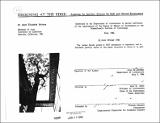| dc.contributor.advisor | John R. Myer. | en_US |
| dc.contributor.author | Hritzay, Anne Elizabeth | en_US |
| dc.contributor.other | Massachusetts Institute of Technology. Dept. of Architecture. | en_US |
| dc.date.accessioned | 2011-12-05T19:46:15Z | |
| dc.date.available | 2011-12-05T19:46:15Z | |
| dc.date.copyright | 1986 | en_US |
| dc.date.issued | 1986 | en_US |
| dc.identifier.uri | http://hdl.handle.net/1721.1/67374 | |
| dc.description | Thesis (M. Arch.)--Massachusetts Institute of Technology, Dept. of Architecture, 1986. | en_US |
| dc.description | MICROFICHE COPY AVAILABLE IN ARCHIVES AND ROTCH. | en_US |
| dc.description | Bibliography: p. 147-150. | en_US |
| dc.description.abstract | Architectural form embodies layers of cultural meaning which reveal people's attitude about their connection to their world. Architectural form has the capacity to contain a plethora of statements about the individual identity of the builders and occupants, as well as a general statement about their place within the continuum of human history. Traditional architectural forms have shown past civilizations to be much more responsive to their natural context, deriving ordering and building systems from the immediate environment. Increasingly however, architectural forms have arisen from more abstract concepts of order. The past few decades have witnessed rationalist expression of building forms underscoring the disconnection from the greater natural cycle of existence as a generative basis of form making systems. This attitude denies the opportunity for buildings to express cultural meaning about people's natural interconnection, in addition to formal geometric expressions. The "modern architectural movement", set within the framework of our current state of cultural development in a technological age, has contributed to alienating people from the natural world in which they are integrally entwined. In order to bridge the gap formed between natural ordering systems and current design expression in a technological age, this thesis explores design as an integration of built and natural form. The design of a retreat center in a dominant natural setting is the vehicle for this exploration. It embodies both functional (programmatic) and physical (architectural form) aspects through an integrated order which can facilitate people's reconnection to the natural order. | en_US |
| dc.description.statementofresponsibility | by Anne Elizabeth Hritzay. | en_US |
| dc.format.extent | 165 p. | en_US |
| dc.language.iso | eng | en_US |
| dc.publisher | Massachusetts Institute of Technology | en_US |
| dc.rights | M.I.T. theses are protected by
copyright. They may be viewed from this source for any purpose, but
reproduction or distribution in any format is prohibited without written
permission. See provided URL for inquiries about permission. | en_US |
| dc.rights.uri | http://dspace.mit.edu/handle/1721.1/7582 | en_US |
| dc.subject | Architecture. | en_US |
| dc.title | Designing at the edge : exploring the interface between the built and natural environment | en_US |
| dc.type | Thesis | en_US |
| dc.description.degree | M.Arch. | en_US |
| dc.contributor.department | Massachusetts Institute of Technology. Department of Architecture | |
| dc.identifier.oclc | 15463876 | en_US |
